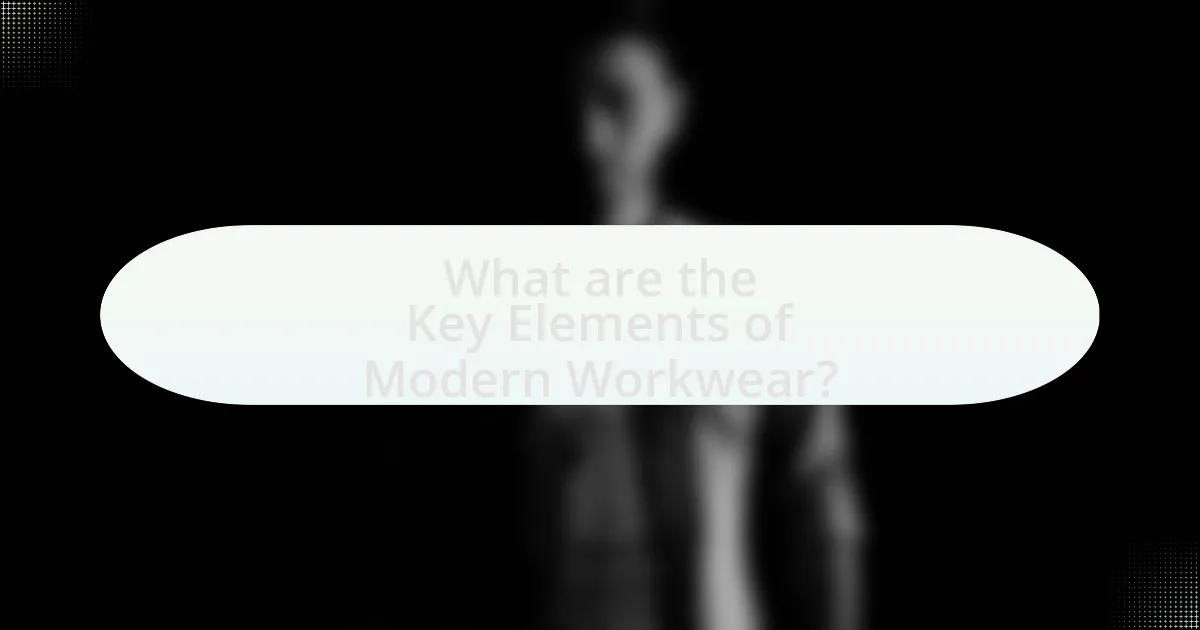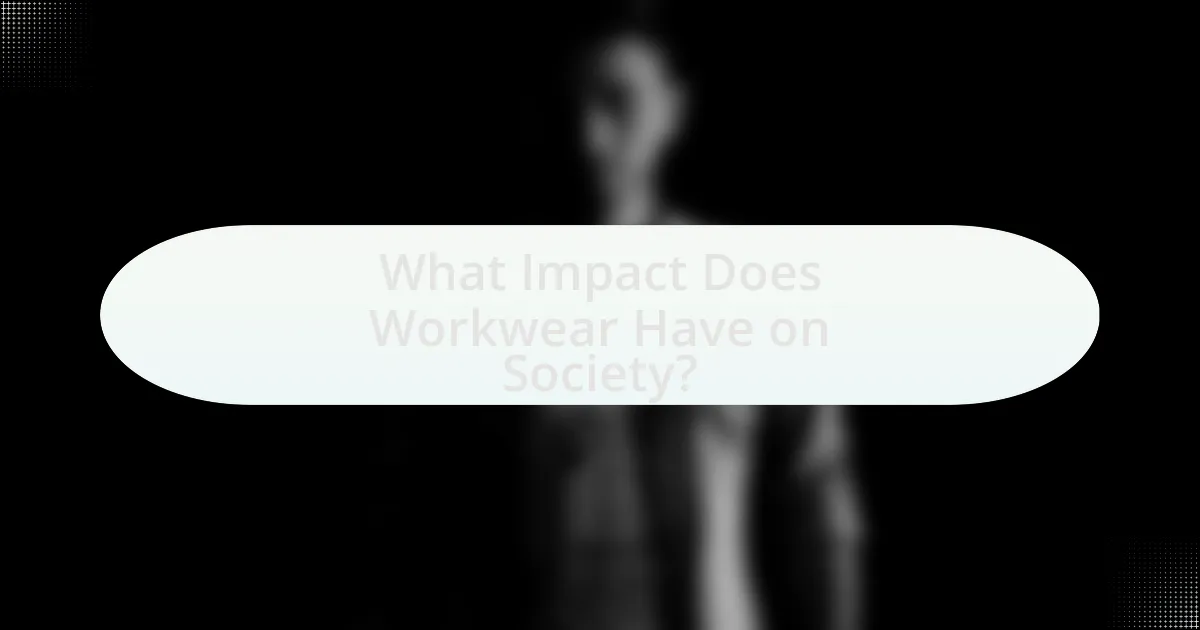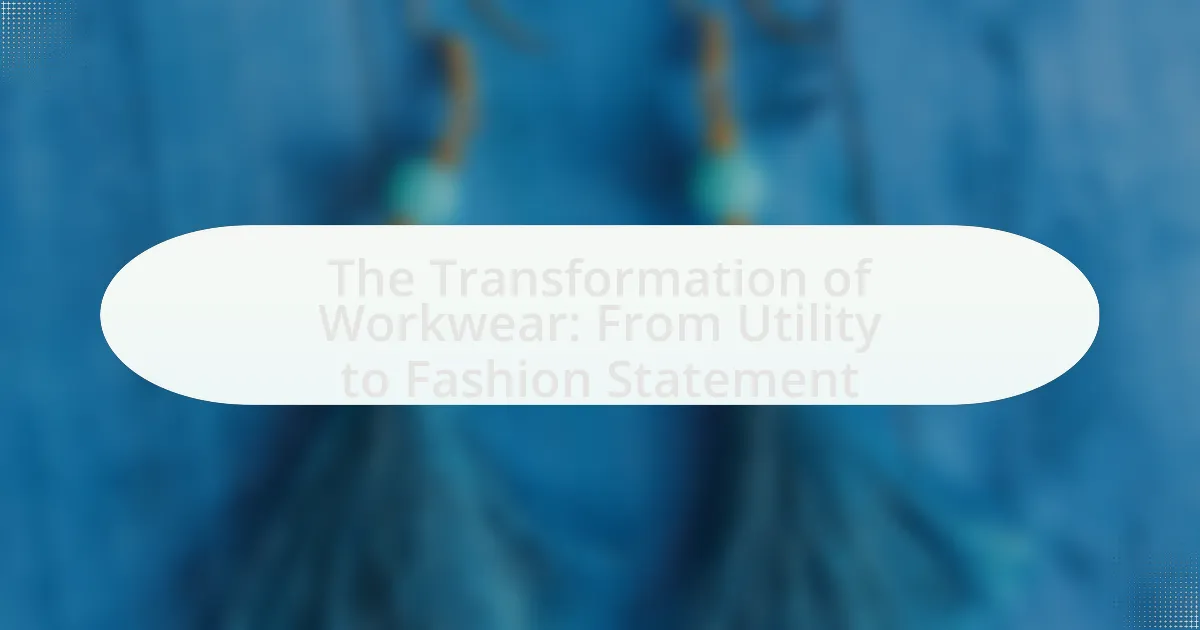The article examines the transformation of workwear from purely functional clothing to fashionable garments that serve as style statements. It outlines the historical evolution of workwear, influenced by industrialization and cultural shifts, highlighting how brands have merged traditional styles with contemporary fashion trends. Key elements of modern workwear, such as functionality, comfort, durability, and style, are discussed, along with the impact of sustainability on material choices. The article also explores the psychological effects of workwear on workplace culture and identity, as well as the implications of workwear trends on the fashion industry, including collaborations between workwear brands and high fashion.

What is the Transformation of Workwear?
The transformation of workwear refers to the evolution of clothing designed for occupational purposes into garments that also serve as fashion statements. Historically, workwear was primarily functional, designed for durability and practicality in various labor-intensive environments. However, in recent years, this category has shifted significantly, influenced by trends in streetwear and high fashion, leading to the incorporation of stylish elements, designer collaborations, and a focus on aesthetics alongside functionality. This shift is evidenced by the rise of brands that blend traditional workwear styles with contemporary fashion, reflecting a broader cultural acceptance of casual and utilitarian styles in everyday life.
How has workwear evolved over the decades?
Workwear has evolved significantly over the decades, transitioning from purely functional garments to stylish and versatile clothing. In the early 20th century, workwear was primarily designed for durability and safety, with materials like denim and canvas being common for labor-intensive jobs. By the 1950s and 1960s, workwear began to incorporate elements of fashion, influenced by youth culture and the rise of casual dress codes, leading to the popularity of items like coveralls and chore jackets.
In the 1980s and 1990s, brands started to merge workwear with streetwear, creating a trend that emphasized both practicality and style. This shift was marked by the introduction of designer collaborations and the use of innovative materials, enhancing both comfort and aesthetic appeal. Today, workwear continues to evolve, with a focus on sustainability and inclusivity, reflecting broader societal changes and consumer preferences. The modern workwear market now includes a variety of styles that cater to different professions while also serving as fashion statements, demonstrating its transformation from utility to a key component of contemporary wardrobes.
What historical factors influenced the initial design of workwear?
The initial design of workwear was influenced by the Industrial Revolution, which necessitated durable and functional clothing for laborers in factories. As industries expanded in the 18th and 19th centuries, workers required garments that could withstand harsh conditions and provide safety, leading to the adoption of materials like denim and canvas. Additionally, the rise of specific trades, such as mining and construction, prompted the creation of specialized workwear designed for protection against environmental hazards. Historical evidence shows that uniforms and standardized clothing emerged to promote worker identity and discipline, further shaping the design of workwear during this period.
How did industrialization impact workwear styles?
Industrialization significantly transformed workwear styles by introducing standardized, durable fabrics and practical designs suited for factory labor. The rise of mass production in the late 19th century led to the creation of garments like overalls and uniforms, which prioritized functionality and safety over aesthetics. This shift was driven by the need for workers to have clothing that could withstand harsh working conditions, as evidenced by the widespread adoption of denim in workwear, which became popular due to its durability. Additionally, the emergence of labor movements in the early 20th century further influenced workwear, as workers began to demand clothing that represented their identity and solidarity, leading to styles that combined utility with a sense of .
Why is workwear considered a fashion statement today?
Workwear is considered a fashion statement today due to its blend of functionality and style, reflecting contemporary trends in casual and streetwear. The rise of athleisure and the influence of high-profile fashion designers have transformed traditional workwear into a symbol of modern aesthetics. For instance, brands like Carhartt and Dickies have collaborated with fashion designers, elevating their utilitarian designs to runway status, which has increased their appeal beyond the workplace. Additionally, the growing emphasis on comfort and practicality in everyday fashion has led consumers to embrace workwear as a versatile choice for various occasions, further solidifying its status as a fashion statement.
What cultural shifts contributed to the rise of workwear in fashion?
The rise of workwear in fashion is primarily attributed to the cultural shifts towards casualization and the blending of formal and informal attire. As workplaces increasingly adopted relaxed dress codes, influenced by the tech industry’s informal culture and the rise of remote work, traditional boundaries between work and leisure clothing began to blur. This shift was further propelled by the growing emphasis on comfort and functionality in everyday wear, as seen in the popularity of athleisure and streetwear. Additionally, the fashion industry’s embrace of sustainability and ethical production has led to a resurgence of durable, utilitarian styles, reflecting a consumer preference for practicality and longevity in clothing choices.
How do modern designers reinterpret traditional workwear?
Modern designers reinterpret traditional workwear by blending functionality with contemporary aesthetics, creating garments that serve both practical and fashion-forward purposes. This transformation is evident in the use of high-quality materials, innovative designs, and versatile silhouettes that cater to a broader audience beyond the workplace. For instance, brands like Carhartt and Dickies have introduced streetwear-inspired collections that maintain the durability of traditional workwear while appealing to urban fashion trends. Additionally, the incorporation of sustainable practices and ethical production methods reflects a shift in consumer values, further enhancing the relevance of workwear in today’s fashion landscape.

What are the Key Elements of Modern Workwear?
The key elements of modern workwear include functionality, comfort, durability, and style. Functionality is essential as modern workwear is designed to accommodate various tasks, often incorporating features like pockets, tool loops, and moisture-wicking fabrics. Comfort is prioritized through ergonomic designs and breathable materials, ensuring that workers can perform their duties without restriction. Durability is critical, with fabrics that withstand wear and tear, often featuring reinforced stitching and water-resistant properties. Lastly, style has become increasingly important, as workwear now reflects personal identity and brand image, blending professional appearance with contemporary fashion trends. This evolution is supported by industry shifts where brands like Carhartt and Dickies have successfully merged utility with aesthetic appeal, demonstrating that workwear can be both practical and stylish.
What materials are commonly used in contemporary workwear?
Contemporary workwear commonly utilizes materials such as cotton, polyester, nylon, and blends of these fabrics. Cotton is favored for its breathability and comfort, while polyester offers durability and moisture-wicking properties. Nylon is often used for its strength and resistance to abrasion. Blended fabrics combine the benefits of these materials, enhancing performance and comfort in various work environments. The choice of these materials reflects the evolving needs of workers for functionality, comfort, and style in modern work settings.
How do fabric choices affect functionality and style?
Fabric choices significantly influence both functionality and style in workwear. Different fabrics offer varying levels of durability, breathability, and comfort, which directly impact the wearer’s performance and experience. For instance, cotton is known for its breathability and comfort, making it suitable for warmer environments, while synthetic fabrics like polyester provide moisture-wicking properties, enhancing functionality in active settings.
Moreover, the aesthetic appeal of fabrics contributes to the overall style of workwear. Textures, colors, and patterns can transform a utilitarian garment into a fashion statement. For example, a sleek, tailored look can be achieved with high-quality wool, while denim can convey a more casual, rugged style. The choice of fabric thus not only determines how well the clothing performs in various conditions but also how it is perceived in terms of fashion, aligning with the evolving trends in workwear that blend utility with style.
What role does sustainability play in modern workwear materials?
Sustainability plays a crucial role in modern workwear materials by driving the development and use of eco-friendly fabrics and production processes. This shift is largely due to increasing consumer demand for environmentally responsible products, which has led manufacturers to adopt sustainable practices such as using organic cotton, recycled polyester, and low-impact dyes. For instance, a report by the Global Fashion Agenda indicates that the fashion industry is responsible for 10% of global carbon emissions, prompting a push towards sustainable alternatives to mitigate environmental impact.
How do design features enhance the appeal of workwear?
Design features enhance the appeal of workwear by combining functionality with aesthetics, making garments not only practical but also stylish. For instance, the incorporation of modern fabrics that offer breathability and durability, along with tailored fits and contemporary colors, attracts a broader audience seeking both comfort and visual appeal. Additionally, features such as reflective strips for safety and pockets designed for convenience add to the garment’s utility while maintaining a fashionable look. This dual focus on style and practicality has led to a significant shift in consumer perception, where workwear is increasingly viewed as a fashion statement rather than merely functional attire.
What specific design elements are trending in workwear fashion?
Current trends in workwear fashion include oversized silhouettes, utilitarian pockets, and sustainable materials. Oversized silhouettes provide comfort and ease of movement, reflecting a shift towards relaxed styles in professional settings. Utilitarian pockets enhance functionality, catering to the need for practicality in work environments. Sustainable materials, such as organic cotton and recycled fabrics, are increasingly favored as consumers prioritize eco-friendly choices. These elements collectively signify a transformation in workwear, merging utility with contemporary fashion sensibilities.
How do these features cater to both utility and aesthetics?
The features of modern workwear cater to both utility and aesthetics by integrating functional design elements with stylish aesthetics. For instance, the use of durable materials ensures that workwear withstands harsh conditions while also being tailored to fit contemporary fashion trends, such as slim cuts and vibrant colors. This dual focus is evident in brands that prioritize ergonomic designs, which enhance comfort and mobility, alongside visually appealing details like unique stitching or patterns. Research indicates that consumers increasingly seek clothing that serves practical purposes without sacrificing style, reflecting a shift in workwear from purely functional garments to versatile pieces suitable for various settings.

What Impact Does Workwear Have on Society?
Workwear significantly impacts society by influencing workplace culture, identity, and social norms. The evolution of workwear from purely functional attire to fashionable clothing reflects broader societal changes, including the rise of casual work environments and the blending of professional and personal identities. For instance, a study by the Fashion Institute of Technology found that 70% of employees feel more confident and productive when wearing comfortable, stylish work attire, indicating that workwear can enhance job satisfaction and performance. Additionally, the adoption of workwear as a fashion statement has led to increased inclusivity and diversity in professional settings, as brands now cater to various body types and cultural backgrounds, promoting a more equitable workplace.
How does workwear influence workplace culture?
Workwear significantly influences workplace culture by shaping employee identity and promoting a sense of belonging. When organizations adopt specific workwear, it fosters unity and professionalism among employees, which can enhance collaboration and communication. For instance, a study by the Journal of Occupational Health Psychology found that uniforms can increase feelings of team cohesion and reduce social barriers, leading to improved workplace morale. Additionally, the evolution of workwear from purely functional attire to stylish options reflects and reinforces a company’s values and brand identity, impacting how employees perceive their roles and responsibilities within the organization.
What are the psychological effects of wearing workwear in professional settings?
Wearing workwear in professional settings can enhance feelings of professionalism and confidence among employees. This effect is supported by research indicating that clothing can influence psychological states and behaviors, a phenomenon known as “enclothed cognition.” For instance, a study published in the Journal of Experimental Social Psychology by Adam Hajo and colleagues found that individuals wearing formal attire performed better on cognitive tasks, suggesting that workwear can positively impact focus and productivity. Additionally, wearing workwear can foster a sense of belonging and team identity, as uniforms or specific attire often signify membership in a professional group, reinforcing social connections and workplace cohesion.
How does workwear contribute to a sense of identity among workers?
Workwear contributes to a sense of identity among workers by providing a visual representation of their roles and values within a professional environment. This type of clothing often signifies belonging to a specific trade or organization, fostering a sense of community and among employees. For instance, uniforms in industries such as healthcare or law enforcement not only denote authority and professionalism but also create a shared identity among workers, enhancing teamwork and collaboration. Studies have shown that wearing specific work attire can influence self-perception and behavior, reinforcing the idea that clothing can shape how individuals view themselves and their roles in the workplace.
What are the implications of workwear trends on the fashion industry?
Workwear trends significantly influence the fashion industry by blurring the lines between functional clothing and high fashion. This shift has led to an increased demand for versatile, durable garments that prioritize comfort and style, reflecting a broader cultural movement towards casualization in everyday attire. For instance, the rise of brands like Carhartt and Dickies in mainstream fashion showcases how traditional workwear aesthetics are being embraced by luxury designers, resulting in collaborations that elevate utilitarian designs to runway status. This trend is supported by market research indicating that the global workwear market is projected to grow, with a compound annual growth rate of 6.5% from 2021 to 2028, highlighting the commercial viability of integrating workwear elements into contemporary fashion.
How do collaborations between workwear brands and high fashion shape consumer perceptions?
Collaborations between workwear brands and high fashion significantly shape consumer perceptions by blending functionality with luxury, thereby elevating the status of workwear in the fashion hierarchy. These partnerships often result in innovative designs that appeal to a broader audience, as seen in collaborations like the one between Carhartt and A.P.C., which successfully merged rugged utility with high-end aesthetics. This fusion not only enhances the desirability of workwear but also challenges traditional notions of fashion, positioning workwear as a stylish choice rather than merely practical attire. The increased visibility and prestige associated with high fashion collaborations lead consumers to perceive workwear as a versatile and fashionable option, ultimately transforming its image from purely utilitarian to a sought-after fashion statement.
What challenges do traditional workwear brands face in the fashion market?
Traditional workwear brands face significant challenges in the fashion market, primarily due to shifting consumer preferences towards style and sustainability over functionality alone. As fashion trends evolve, these brands struggle to adapt their designs to meet the demand for fashionable aesthetics while maintaining the durability and utility that define their products. Additionally, competition from fast fashion retailers, which offer trendy and affordable alternatives, further pressures traditional workwear brands to innovate rapidly. According to a report by McKinsey & Company, the global apparel market is increasingly influenced by consumer desire for sustainable practices, compelling traditional brands to rethink their production methods and materials to remain relevant.
What are some practical tips for incorporating workwear into everyday fashion?
Incorporating workwear into everyday fashion can be achieved by selecting versatile pieces that blend functionality with style. Start by choosing tailored trousers or chinos, which can be paired with casual tops for a polished yet relaxed look. Layering work shirts under sweaters or blazers adds sophistication while maintaining comfort. Accessories such as sturdy boots or minimalist sneakers can elevate the outfit, providing a balance between ruggedness and urban chic. Additionally, incorporating workwear fabrics like denim or canvas in everyday outfits enhances durability and style. This approach reflects the trend where workwear has evolved into a fashion statement, as evidenced by its presence in high-fashion runways and street style, showcasing its adaptability beyond traditional settings.
How can individuals style workwear pieces for casual settings?
Individuals can style workwear pieces for casual settings by pairing them with relaxed items that soften their structured appearance. For example, a tailored work blazer can be worn over a graphic tee and distressed jeans, creating a balanced look that maintains professionalism while embracing comfort. Additionally, incorporating accessories like sneakers or casual loafers can further enhance the laid-back vibe. This approach is supported by fashion trends that emphasize versatility, as seen in the rise of athleisure and smart-casual styles, which blend formal and informal elements seamlessly.
What are the best practices for selecting versatile workwear items?
The best practices for selecting versatile workwear items include prioritizing functionality, choosing neutral colors, and ensuring a good fit. Functionality is essential as it allows the clothing to serve multiple purposes, such as being suitable for both office and casual settings. Neutral colors like black, navy, and gray enhance versatility, making it easier to mix and match with various outfits. A good fit is crucial because well-fitted clothing not only looks professional but also allows for ease of movement, which is important in a work environment. These practices are supported by industry trends that emphasize the importance of adaptability in modern workwear, reflecting a shift towards clothing that balances style and practicality.

Leave a Reply